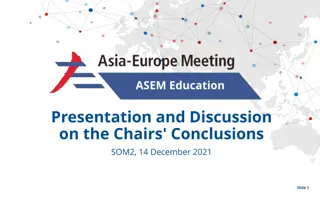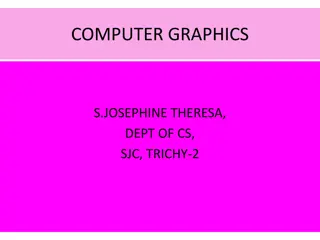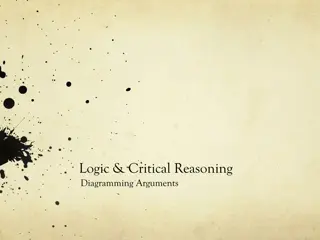Making Inferences and Drawing Conclusions
Readers construct meaning by inferring unstated meanings based on social conventions, shared experience, and shared values. Inferences are evidence-based guesses drawn from what is actually said, enabling readers to understand implications and draw conclusions. Tips for reading include relying on th
0 views • 10 slides
Understanding Inductive and Deductive Reasoning
Inductive reasoning involves drawing general conclusions from specific observations, while deductive reasoning starts with general premises to derive specific conclusions. Induction uses experience or experimental evidence to make broad conclusions, while deduction follows from general to specific.
5 views • 7 slides
Research Findings and Conclusions on Methodology Implementation
This presentation outlines the importance and objectives of the research, detailing the methodology used and presenting the obtained results. Conclusions are drawn, emphasizing key findings and encouraging further exploration of the topic.
0 views • 9 slides
Structuring Your Essay Conclusion Effectively
Understand the importance of essay conclusions, learn how to structure a conclusion, identify key elements of a good conclusion, reiterate the question, summarize main points, present conclusions or hypotheses, and ensure the question is answered with supporting evidence.
0 views • 12 slides
Crafting Strong Conclusions: A Guide for Effective Endings
Conclusions in academic writing serve to wrap up discussions, restate key points without repetition, and possibly suggest future research directions or call to action. It is crucial to avoid introducing new information in the conclusion and aim for clarity and conciseness. This guide provides insigh
0 views • 6 slides
Understanding the Distinction Between Findings of Fact and Conclusions of Law
The distinction between findings of fact and conclusions of law is explored through various legal opinions and cases. The complexity and importance of this distinction are highlighted, with instances where findings are deemed as conclusions and vice versa. Scholars and legal experts have pondered ov
0 views • 24 slides
Presentation and Discussion on Chairs' Conclusions - SOM2, 14 December 2021
Presentation and discussion on the Chairs' conclusions from ASEMME8, covering topics such as Strategy 2030, commitment to AEP, projects undertaken between ASEMME7 and ASEMME8, and more. The Chairs expressed gratitude to host countries and stakeholders involved in implementing initiatives and project
0 views • 15 slides
Understanding Significance Testing in Statistics
Significance testing is a vital concept in statistics used to analyze data and make informed conclusions about population parameters. This lesson delves into the significance test procedure, hypotheses formulation, interpreting P-values, and drawing appropriate conclusions based on statistical evide
2 views • 9 slides
Analyzing Arguments in Various Contexts
The provided content involves analyzing whether certain passages present arguments or not. It includes examples where premises lead to conclusions, such as the benefits of exercise and the moral implications of executive pay discrepancies. Each passage is evaluated to determine the existence of logi
0 views • 35 slides
Proposal and Thesis Presentation Template for Industrial Engineering Department
These slides serve as a comprehensive template for proposal and thesis presentations in the Industrial Engineering Department. They guide students on structuring their research, from background to conclusions, assisting them in showcasing their work effectively. The template emphasizes the importanc
0 views • 11 slides
Mastering the Art of Persuasive Speech
Crafting a persuasive speech involves captivating introductions, compelling content, and impactful conclusions. Learn the essential elements: attracting attention, establishing credibility, motivating action, and more. Explore methods for developing engaging introductions and powerful conclusions. D
3 views • 31 slides
Exploring Orthographic Drawing in Design and Technology Education
Delve into the world of orthographic drawing through St. Columba's Design and Technology Department's S1 Graphic Communication program. Discover the significance of orthographics in visualizing 3D objects as 2D drawings, learn about orthographic views like Elevation, Plan, and End Elevation, and exp
0 views • 8 slides
Tonal Shading Drawing Techniques Lesson for Upper KS2
Develop your drawing technique in creating tone with light, medium, and dark tones using cross-hatching, blending, and stippling. Apply these techniques to make objects appear 3D. Explore the importance of tone in drawing, experiment with different shading techniques, and apply them to compositions.
6 views • 6 slides
Evaluating the Validity of Rosenhan's Conclusions in Psychology
Some psychologists question the validity of Rosenhan's conclusions due to methodological flaws in his study, such as lack of generalizability and potential biases. Critics argue that the findings may not accurately reflect real-world psychiatric settings, leading to skepticism about their applicabil
0 views • 250 slides
Pixel Array Status and Drawing Rules for High-Resistivity Epi Design
This collection of images and descriptions provides an overview of the pixel array status as of April 26, 2019, along with drawing rules for high-resistivity epi design. The pixel array features various components such as Pixel_S1, Pixel_S3, and the overall array structure. Drawing rules highlight t
4 views • 9 slides
Understanding Symmetrical DDA and Bresenham's Line Drawing Algorithm
The content discusses the Symmetrical DDA (Digital Differential Analyzer) and Bresenham's Algorithm for line drawing in computer graphics. Symmetrical DDA generates lines from differential equations, while Bresenham's Algorithm iteratively changes coordinate values to draw lines effectively. The pro
0 views • 11 slides
Understanding Biases in Sampling Methods
Statistical studies rely on samples to draw conclusions about populations, but the method of sampling can introduce biases. This text discusses convenience sampling, voluntary response sampling, random sampling, and the implications of biased sampling methods on study results. It highlights how bias
1 views • 12 slides
Mastering Introductions and Conclusions for Engaging Presentations
Learn the essential elements of crafting powerful introductions and conclusions for your presentations. Explore strategies to captivate your audience, establish credibility, and leave a lasting impact. Discover techniques such as using rhetorical questions, impactful quotations, and startling facts
0 views • 38 slides
Exploring Argument Structure and Diagramming in Critical Reasoning
Understanding the two types of argument structures - atomic and complex, with examples and diagrams. Learn how argument diagrams visually represent the structure of an argument, identify significant units like premises and conclusions, and distinguish main conclusions from sub-conclusions. Dive into
1 views • 10 slides
Task 4.3 Meeting Conclusions and Next Steps
The Task 4.3 meeting held on Dec 16-17, 2019, discussed key conclusions and outlined next steps for the ESCAPE project funded by the European Union. The meeting covered topics such as tech forums, hackathons, platform capabilities, imaging plans, progress reports, and future demos. Spectra analysis,
0 views • 4 slides
Chile Country Portfolio Evaluation 2010-2014 Summary
Evaluation process of Chile's country portfolio from 2010-2014 included pre-evaluation, during evaluation, and results/conclusions phases. Challenges like defining scope and participant concerns were addressed. Preliminary conclusions were presented to stakeholders, leading to a trustful and represe
1 views • 6 slides
Exploring Drawing Capabilities in Pygame: Shapes, Multimedia, and More
Utilize Pygame to go beyond drawing rectangles and explore drawing circles, lines, shapes of any format, and importing images. Enjoy playing music and multiple sounds simultaneously. Learn about useful functions in the Draw module and how to draw various shapes onto Surfaces using parameters and fun
0 views • 26 slides
Understanding the Scientific Method and Examples
The scientific method is a systematic approach to answering questions and solving problems. It involves steps like observation, asking questions, forming hypotheses, collecting data, organizing data, and drawing conclusions. This method helps researchers find answers efficiently and allows others to
0 views • 9 slides
Creating Interactive Drawing App in Flutter
Learn how to create an interactive drawing app in Flutter using GestureDetector for touch input, CustomPaint for rendering, and storing drawing information dynamically. Implement features like color selection, line width adjustment, and gesture detection to enable users to draw on the screen efficie
0 views • 19 slides
Introduction to Engineering Drawing and Techniques
Engineering drawing is a fundamental aspect of communicating ideas and designs in the fields of Mechanical, Electrical, and Civil Engineering. This form of visual communication utilizes lines to represent object surfaces, edges, and contours. Various drawing methods such as Freehand, Instrument-base
0 views • 55 slides
Introduction to Engineering Drawing Language and Drawing Tools
Engineering Drawing Language uses lines to depict object surfaces, edges, and contours, while Freehand Drawing is sketched without instruments. Drawing Instruments ensure precise drawings to scale. Learn to draw horizontal and vertical lines, and angles using drawing tools like T-Square and triangle
0 views • 29 slides
Nature Drawing Tasks for Art Class
Complete a series of nature drawing tasks including recreating shells, creating skull drawings, experimenting with mark making techniques, and working on charcoal drawings. Reflect on your work to improve and develop your drawing skills further.
0 views • 6 slides
Raster Graphics and Scan Conversion in Computer Graphics
This lecture covers various topics related to raster graphics and scan conversion in computer graphics. It includes issues with scan converting a line, generalized line drawing algorithms, and the midpoint circle drawing algorithm. Additionally, it explores deriving mathematical expressions for draw
0 views • 21 slides
Understanding Observations in Science
Observations in science are essential for gathering data and drawing conclusions. This includes making qualitative and quantitative observations, using senses and tools to increase accuracy, and distinguishing facts from opinions. Inferences are conclusions drawn based on observations and data. Prac
0 views • 13 slides
EPRI's GMD Research Updates and Preliminary Conclusions
EPRIs GMD workshop presented updates on research projects focusing on the impacts of geomagnetic disturbances (GMD) on the bulk power system. The workshop highlighted ongoing and upcoming projects, including assessments of transformer thermal impacts, GIC estimation models, geoelectric field enhance
0 views • 16 slides
Bresenham Line Drawing Algorithm Explained with Examples
Bresenham Line Drawing Algorithm is a method used to generate points between starting and ending coordinates to draw lines efficiently. This algorithm involves calculating parameters, decision parameters, and iteratively finding points along the line. Two example problems are provided with step-by-s
0 views • 8 slides
Master AutoCAD 2021 Drawing Tools and Techniques
Explore the powerful features of AutoCAD 2021 including drawing tools for setting limits, line weight adjustments, hatch tool for generating hatch lines, and gradient application. Learn how to set drawing limits, customize line weights, and optimize your drawings efficiently in AutoCAD. The tutorial
0 views • 8 slides
Mastering Introductions and Conclusions for Effective Writing
Explore the art of crafting engaging introductions and impactful conclusions with insights shared by experts. Dive into understanding their structure, crucial components, and how to modify or create them effectively. Engage in hands-on activities to enhance your skills in building compelling opening
0 views • 22 slides
Analyzing Conclusions Through Picture Interpretation
Utilizing visual cues and background knowledge, this exercise involves making claims based on images and supporting those claims with evidence. The sample pictures provided focus on a celebratory scene related to a Super Bowl victory and emphasize the importance of drawing conclusions from visual co
0 views • 9 slides
Mastering Conclusions in English Publishing Research
Conclusions in English publishing research play a crucial role in offering a final insight, emphasizing the significance of your paper, drawing conclusions from results, and potentially leading to broader discussions. Avoid repeating content, focus on coherence, echo your introduction, and pose thou
0 views • 14 slides
Metal Drawing Process for Creating Hollow Vessels
Metal drawing is a cold forming process that transforms a flat sheet metal blank into a hollow vessel without wrinkles or fractures. By applying force with a punch, the metal is drawn into a die cavity to shape the blank into a cup-like form. This process involves setup similar to blanking but with
0 views • 19 slides
Analyzing Links Between Social Exclusion and Health in Scotland
Analyzing the relationship between social exclusion and health in Scotland, this task requires drawing conclusions based on evidence from multiple sources. Examples provided demonstrate how social exclusion impacts health outcomes, with varying levels of evaluative language and synthesis between sou
0 views • 17 slides
Misleading Conclusions Based on Statistical Significance at the 2020 ECSS Conference
Researcher Will Hopkins challenges the traditional use of statistical significance in drawing conclusions about effects in sports science research. His analysis of presentations at the 2020 ECSS Conference reveals how significance testing can lead to misleading interpretations. By emphasizing the im
0 views • 6 slides
Bresenham's Circle Drawing Algorithm Explained
Bresenham's Circle drawing algorithm is a fast and efficient method for drawing circles using integer arithmetic. It divides the circle into octants and selects the nearest pixel positions to create smooth arcs. This algorithm is widely used for graphics applications due to its speed and accuracy.
0 views • 15 slides
Developing Drawing Techniques for Tone in Lower KS2 - Lesson 2
In this lesson, students will enhance their drawing skills by experimenting with techniques such as cross-hatching, blending, and stippling to create tone. They will learn about key terms like light, medium, dark, shadow, and highlight, and engage in activities that help them understand the importan
0 views • 5 slides






































